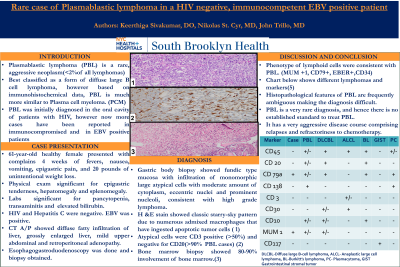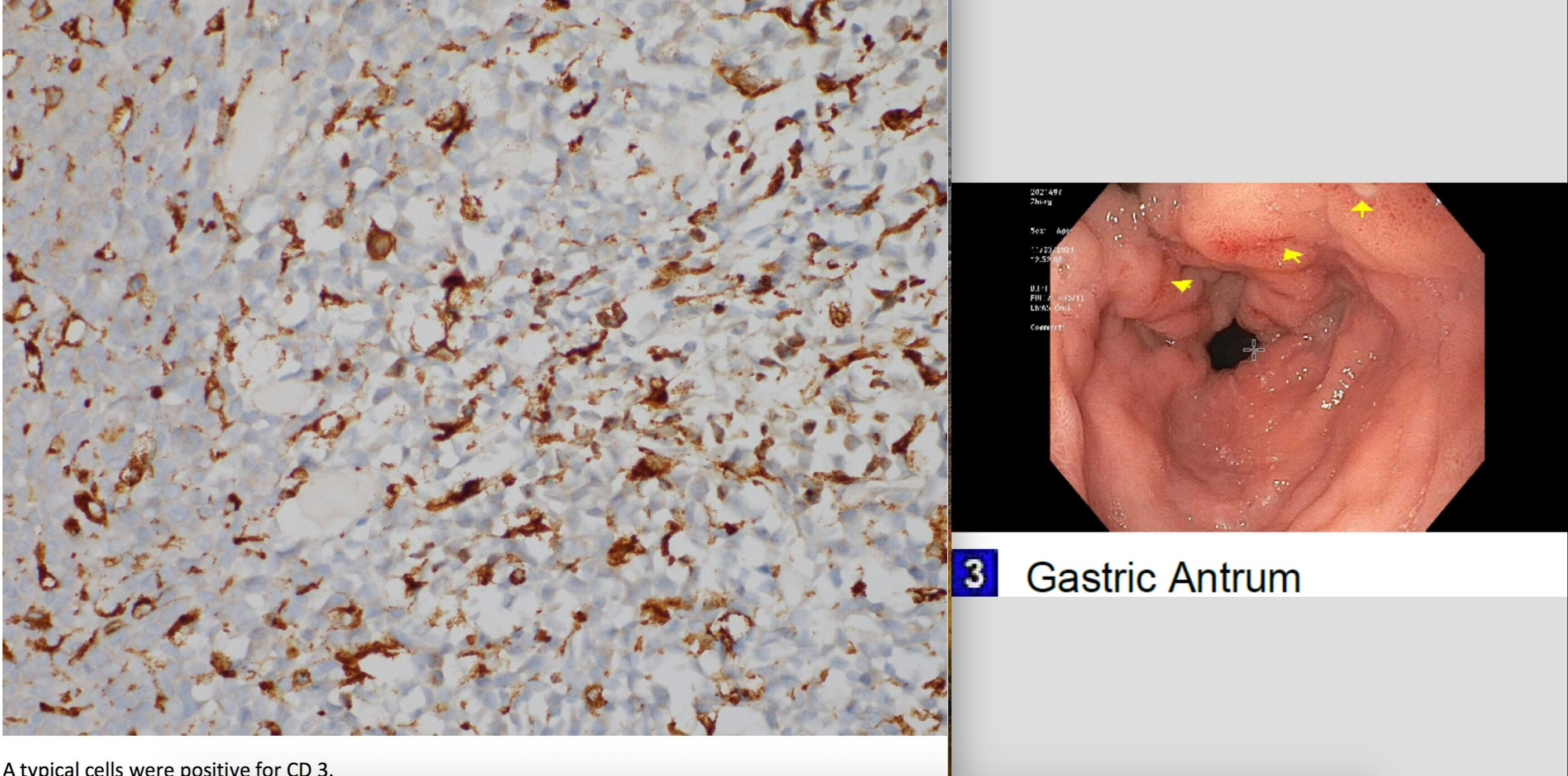Back


Poster Session D - Tuesday Morning
Category: Stomach
D0699 - Extremely Rare Case of Plasmablastic Lymphoma in a HIV-Negative, Immunocompetent, EBV-Positive Patient
Tuesday, October 25, 2022
10:00 AM – 12:00 PM ET
Location: Crown Ballroom

Has Audio
- KS
Keerthiga Sivakumar, DO
Coney Island Hospital
Brooklyn, NY
Presenting Author(s)
Keerthiga Sivakumar, DO, Nikolas St.Cyr, MD, John Trillo, MD
Coney Island Hospital, Brooklyn, NY
Introduction: Plasmablastic lymphoma (PBL) is a rare and aggressive large B-cell lymphoma commonly diagnosed in the oral cavity in patients with human immunodeficiency viruses(HIV), however, it has been occasionally seen in patients who are immunocompromised as well as with EBV (Epstein-Barr virus). About 95 percent of the world’s population is affected by EBV and in most cases, causes no symptoms to minor non-specific symptoms to infectious mononucleosis. Infected individuals become lifetime asymptomatic carriers and in some very extreme cases, these carriers develop EBV-positive plasmablastic lymphoma. PBL in an immunocompetent patient is rare and when present most often is seen in the gastrointestinal (GI) tract. When present in the GI tract, most cases present with B-symptoms.
Case Description/Methods: The patient is a healthy 61-year-old female with a history of GERD who presented with complaints of 4 weeks of fevers, nausea, vomiting, epigastric pain, poor appetite with 20 pounds of unintentional weight loss.
On physical exam, the patient was afebrile and tachycardic. She had epigastric tenderness and splenomegaly. Initial laboratory testing showed the following: Hemoglobin 5.9 g/dL, White blood cell 8.25 k/uL, platelets 85 k/uL, aspartate aminotransferase 142 U/L, alanine aminotransferase 61 U/L, alkaline phosphatase 220 U/L, total bilirubin 10.7 mg/dL, prothrombin time 34.3 seconds, fibrinogen 95 mg/dL, and d-dimer 6.5 ug/mL. CT (computed tomography) of the chest, abdomen, and pelvis showed diffuse fatty infiltration of the liver, grossly enlarged liver, and mild upper abdominal and retroperitoneal adenopathy. Infectious work up for HIV (human immunodeficiency virus) negative Hepatitis C virus weakly positive. EBV positive.
Esophagogastroduodenoscopy was done and gastric body biopsy showed fundic type mucosa showing infiltration of the lamina propria by monomorphic large atypical cells with a moderate amount of cytoplasm, eccentric nuclei, and prominent nucleoli, consistent with high-grade lymphoma. Atypical cells are CD3 positive ( >50%) and negative for CD20 and CD30. Bone marrow biopsy showed plasmablastic lymphoma, 80-90% involvement of bone marrow.
Discussion: PBL is a rare and aggressive lymphoma with a poor prognosis. Five-year survival rate recorded no more than 33.5%. It requires a high level of suspicion and awareness both by physicians and pathologists to diagnose and treat. No chemotherapy regimen is considered a standard of care for PBL at this time.

Disclosures:
Keerthiga Sivakumar, DO, Nikolas St.Cyr, MD, John Trillo, MD. D0699 - Extremely Rare Case of Plasmablastic Lymphoma in a HIV-Negative, Immunocompetent, EBV-Positive Patient, ACG 2022 Annual Scientific Meeting Abstracts. Charlotte, NC: American College of Gastroenterology.
Coney Island Hospital, Brooklyn, NY
Introduction: Plasmablastic lymphoma (PBL) is a rare and aggressive large B-cell lymphoma commonly diagnosed in the oral cavity in patients with human immunodeficiency viruses(HIV), however, it has been occasionally seen in patients who are immunocompromised as well as with EBV (Epstein-Barr virus). About 95 percent of the world’s population is affected by EBV and in most cases, causes no symptoms to minor non-specific symptoms to infectious mononucleosis. Infected individuals become lifetime asymptomatic carriers and in some very extreme cases, these carriers develop EBV-positive plasmablastic lymphoma. PBL in an immunocompetent patient is rare and when present most often is seen in the gastrointestinal (GI) tract. When present in the GI tract, most cases present with B-symptoms.
Case Description/Methods: The patient is a healthy 61-year-old female with a history of GERD who presented with complaints of 4 weeks of fevers, nausea, vomiting, epigastric pain, poor appetite with 20 pounds of unintentional weight loss.
On physical exam, the patient was afebrile and tachycardic. She had epigastric tenderness and splenomegaly. Initial laboratory testing showed the following: Hemoglobin 5.9 g/dL, White blood cell 8.25 k/uL, platelets 85 k/uL, aspartate aminotransferase 142 U/L, alanine aminotransferase 61 U/L, alkaline phosphatase 220 U/L, total bilirubin 10.7 mg/dL, prothrombin time 34.3 seconds, fibrinogen 95 mg/dL, and d-dimer 6.5 ug/mL. CT (computed tomography) of the chest, abdomen, and pelvis showed diffuse fatty infiltration of the liver, grossly enlarged liver, and mild upper abdominal and retroperitoneal adenopathy. Infectious work up for HIV (human immunodeficiency virus) negative Hepatitis C virus weakly positive. EBV positive.
Esophagogastroduodenoscopy was done and gastric body biopsy showed fundic type mucosa showing infiltration of the lamina propria by monomorphic large atypical cells with a moderate amount of cytoplasm, eccentric nuclei, and prominent nucleoli, consistent with high-grade lymphoma. Atypical cells are CD3 positive ( >50%) and negative for CD20 and CD30. Bone marrow biopsy showed plasmablastic lymphoma, 80-90% involvement of bone marrow.
Discussion: PBL is a rare and aggressive lymphoma with a poor prognosis. Five-year survival rate recorded no more than 33.5%. It requires a high level of suspicion and awareness both by physicians and pathologists to diagnose and treat. No chemotherapy regimen is considered a standard of care for PBL at this time.

Figure: Atypical cells positive for CD3
Disclosures:
Keerthiga Sivakumar indicated no relevant financial relationships.
Nikolas St.Cyr indicated no relevant financial relationships.
John Trillo indicated no relevant financial relationships.
Keerthiga Sivakumar, DO, Nikolas St.Cyr, MD, John Trillo, MD. D0699 - Extremely Rare Case of Plasmablastic Lymphoma in a HIV-Negative, Immunocompetent, EBV-Positive Patient, ACG 2022 Annual Scientific Meeting Abstracts. Charlotte, NC: American College of Gastroenterology.
